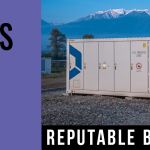 The key value propositions for commercial energy storage are based around “maximising economics subject to operating constraints”, according to Stem and other energy storage system integrators and operators.
The key value propositions for commercial energy storage are based around “maximising economics subject to operating constraints”, according to Stem and other energy storage system integrators and operators.
Discussing the topic of operations and maintenance (O&M) of energy storage systems for a feature article in the just-published latest volume of downstream solar journal PV Tech Power, companies including US-based Stem, German-American storage integrators Younicos and UK companies UK Power Networks and Open Energi offered their views. While O&M in solar PV is a big industry in its own right, marked with a rapid growth in third-party O&M service providers in recent years, the strategies for energy storage tend to be tied more closely to the project’s originators, with system integrators and manufacturers sharing the operational and maintenance aspects of most large-scale and commercial installations.
Essentially, extracting maximum economic value from a battery system, or fleets of aggregated systems in Stem’s case, plays off against the limits of what the battery can achieve in terms of charge and discharge cycles before degradation of the battery begins to affect its efficacy.
Gabe Schwartz, Stem marketing director, said that “once the storage system is there, it’s basically just an empty battery that has the capability of storing a certain amount of energy.”
“What makes it valuable is the operation of it, pretty much second by second every day, for the entire life of the asset – a ‘smart brain’ if you will, telling it exactly when to charge and discharge in order to provide its intended value; you can call that the ‘O’ of the O&M but we think of it as the entire business that we’re in.”
Prioritising behind-the-meter value
While storage systems such as Stem’s can provide grid services to transmission and distribution network operators and utilities, as a commercial operator of behind-the-meter systems, its first priority is to the end customer or system host. Businesses contract Stem to install batteries that can help them lower their electricity costs, first and foremost by providing demand charge reduction.
Demand charges are levied onto commercial and industrial (C&I) electricity customers in many territories. In the US, where Stem has focused to date, these charges, calculated from a C&I customer’s most intensive periods of electricity use in any given month, can make up as much as 50% of a total electricity bill.

 Updates in the compressed air energy storage (CAES) market are hard to come by. Although the technology was proven viable years ago, actual utilization hasn’t occurred for a number of reasons. Geology, however, is the biggest culprit.
Updates in the compressed air energy storage (CAES) market are hard to come by. Although the technology was proven viable years ago, actual utilization hasn’t occurred for a number of reasons. Geology, however, is the biggest culprit. May 31, 2017, Sacramento – The California Senate passed a bill that would give consumers more access to clean energy and provide the next critical piece for California to achieve its aggressive greenhouse gas and renewable energy goals. SB 700, authored by Sen. Scott Wiener (D-San Francisco) would increase availability of local, customer-sited energy storage for schools, farms, businesses and homes.
May 31, 2017, Sacramento – The California Senate passed a bill that would give consumers more access to clean energy and provide the next critical piece for California to achieve its aggressive greenhouse gas and renewable energy goals. SB 700, authored by Sen. Scott Wiener (D-San Francisco) would increase availability of local, customer-sited energy storage for schools, farms, businesses and homes. Many organisations have to manage critical power supplies with technology that can provide full UPS (Uninterruptible Power Supply) functionality, due to the increasing number of brownouts and blackouts the electricity network is experiencing.
Many organisations have to manage critical power supplies with technology that can provide full UPS (Uninterruptible Power Supply) functionality, due to the increasing number of brownouts and blackouts the electricity network is experiencing. Photos taken during the 2012 Hurricane Sandy disaster almost literally turned the spotlight onto microgrids.
Photos taken during the 2012 Hurricane Sandy disaster almost literally turned the spotlight onto microgrids. The DOE’s SHINES program is part of the agency’s Grid Modernization Initiative that aims to improve the resiliency, reliability and security of the nation’s power grid. SHINES itself is the first DOE funding program that looks exclusively at connecting renewable power to storage.
The DOE’s SHINES program is part of the agency’s Grid Modernization Initiative that aims to improve the resiliency, reliability and security of the nation’s power grid. SHINES itself is the first DOE funding program that looks exclusively at connecting renewable power to storage. Called SkelGrid, the system is based on the firm’s curved graphene ultracapacitor technology, which is designed to provide high power and energy density.
Called SkelGrid, the system is based on the firm’s curved graphene ultracapacitor technology, which is designed to provide high power and energy density.



